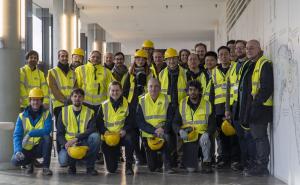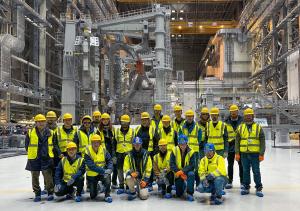A productive week together on site
Following the launch, a meeting of the first group of 19 Fellows to be admitted to the scheme was held at the ITER Organization in September 2016. Since then, the network has expanded to over 60 members, from almost all ITER Members and across all major areas of fusion science of importance to ITER. Currently, these areas are broadly grouped into plasma boundary modelling, fuel retention management, disruption and runaway electron simulations, pedestal confinement and stability, heating and current drive, plasma control, integrated modelling and diagnostics. As a consequence, the majority of network activity falls within the activities of the ITER Science Division, although 15 Fellows are currently associated with plasma diagnostics, managed by the ITER Diagnostics Program.
Before the pandemic, small groups of Fellows in the different areas would visit ITER from time to time, with regular progress meetings taking place by video conference. Larger on-site gatherings effectively ceased from 2019 and, since then, visits have largely been confined to individual Fellows coming to work on specific tasks for a few days or even weeks. However, nothing can really replace the interactions possible during face-to-face meetings, especially when several people with similar expertise can sit together in the same room, mostly away from the day-to-day responsibilities in their home institutes.
It was thus a genuine pleasure between 4-8 December to welcome almost the entire group of Plasma Boundary Modelling and Fuel Retention Management Fellows. These two groups are strongly linked, since assessments of how the fusion fuels are retained in, permeate through and can be recovered from plasma-facing surfaces during ITER operation are intimately associated with the plasma conditions at the plasma-material interface. The simulations of one group thus provide the input for the other.
An additional key aspect of moving to a "full tungsten" first wall (the ITER divertor is already tungsten armoured) is that plasma start-up is known to be an issue requiring particular care based on experience with smaller-scale tokamak devices which have majority tungsten walls (e.g., ASDEX Upgrade in Germany, WEST in France and EAST in China). To ease the challenge, these experiments typically use a plasma chemical vapour deposition technique to coat the plasma-facing surfaces with a very thin layer (tens of nanometres) of boron, which is extremely efficient at absorbing residual oxygen in the ultra-high vacuum conditions required in the tokamak main chamber for efficient plasma start-up. Known as boronization, this coating process is proposed as a new element in the ITER re-baselining, requiring the design and installation of new hardware. A drawback of this technique is that the deposited boron will be eroded by plasma operation and can "migrate" to specific locations on the wall and divertor surfaces, where it can also trap fusion fuels. Estimating the erosion lifetime, the transport of eroded boron and the efficiency with which fuel can be trapped and recovered is squarely within the expertise of the Scientist Fellow Network groups which came together at ITER in early December.
On the first day of the week-long visit, the 16 Scientist Fellows met in plenary session to be briefed by ITER Organization staff on the re-baselining activity, with particular focus on the aspects requiring their expertise. The rest of week was devoted to informal discussions, working sessions on specific technical issues, and the fixing of objectives for work to be performed under the auspices of the re-baselining. A Thursday afternoon tour of the ITER construction site on foot, followed by dinner in the centre of Aix-en-Provence, already fully adorned for the festive season, were highlights of the visit. In a final debrief, it was agreed that the exercise should be repeated in 2024, a lead hopefully to be followed by many of the other Scientist Fellow Network groups next year.
The typical nominees for the Fellowship program have strong international reputations in their area of expertise, often leading teams of scientists in their home institutes. Fellows commit to spending a part of their time working on ITER-related issues and are named for three years with the possibility of renewal. Since the start of the program in 2016, more than 80 percent of the early participants have been renewed. Nominations for the ITER Scientist Fellow Network are accepted on a rolling basis. For questions, please contact @email.



